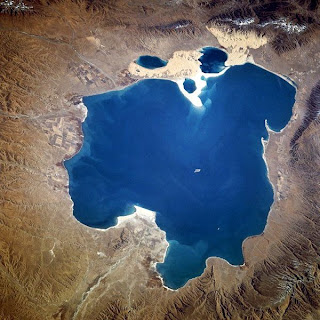The Di, who are an ethnic group
who’s descendents will become the group we call the Han today, first settled
the Qinghai Province nearly six thousand years ago. They were farmers in the
central plains of Qinghai. In 121 B.C. the western Han Dynasty built a fortress
and the Xiping Pavilion in Eastern Qinghai to monitor and control the Yellow
and Huangshui rivers. This was the beginning of the Central Plains Feudal
Dynasties. This lasted until right around the turn of the 4th
century when the Tuyuhun moved into the area and set up their own empire. The
Tubo Dynasty took over in the 7th century uniting the entire Tibetan
Plateau. After that there were a series of different dynasties that took power
until the Mongolian Yuan Dynasty took over in the 13th century. In
1949 the Peoples Republic of China finally got rid of the old feudal system
that remained in place since the province way initially taken over by the Han
Dynasty.
The Yellow River, which flows
across China originates on the Tibetan Plateau in the Qinghai. It travels
through many different provinces in an eastern direction all the way to the
ocean. It has many valleys basins, and has created some very notable gorges
over time such as the Shanxi-Shaanxi Gorge, which is 725 kilometers long making
it the longest gorge on the Yellow River.
On July 1st of 2006 the
Qinghai-Tibet Railway was opened to the public for the first time. The railway
is 1,215 miles long and it has 45 stations along its path, surprisingly 38 of
these stations are not staffed. These unmanned stations are monitored from a central control station that is
located in Xining. I found an interesting fact about the trains themselves.
Even though it would seem that everything here in the US is made in China,
surprisingly enough GE built all of the locomotives that run on the railway in
Pennsylvania.
The Qinghai Lake, which you guessed
it is located in North Eastern Qinghai is a major stop along many different
bird migrations. This poses a possible threat to Europe and Asia because the
lake has so many different types of birds from different regions coming
together in one area there is fear of rapid spread of influenza. The name of
the lake translates literally to Blue Sea Lake, and it sits 10,515 feet above
sea level. The lake has been increasing in size since 2004 and is fed by
twenty-three rivers and streams. In 2007 its surface covered 1,733 square
miles.
The culture of Qinghai is very
unique; the two main religions of the province are Islam and Tibetan Buddhism.
The cultural traditions of the province are a cross from Mongol traditions,
which come from being ruled by the Mongols early on, and Tibetan culture, which
has been absorbed throughout the centuries because Qinghai is located on the
Tibetan Plateau. Interestingly enough one common thing you will find in the
culture of people from Qinghai is that they use yaks for transportation, and
then for their meat once they can no longer be used for transportation. There
are not a whole lot of in depth details about culture in this province, and I feel
this is because the western provinces of China are more rural and do not have a
whole lot of contact with Eastern China.
The main tourist attraction of the
province is the Qinghai Lake. The reason it is popular among Chinese and
Tibetan tourists is because in the summer months it remains at a reasonable
temperature because of its elevation and geographic location. The rolling
grasslands that surround the lake are seemingly the only other tourist
attraction in the province. The area is considered a national level 5A scenic
area, which I can only assume is the equivalent of a nation park here in the
US.
There is one major university in
the province of Qinghai and it enrolls roughly 5,100 students and offers 33
bachelor degrees and 3 graduate degrees. The degrees range from economics to
agriculture to adult education. There are nearly 1000 staff members and half of
which teach and do research work around the university. Just incase you haven’t
guessed the name of the university at this point it to is named after the
province just like the lake and everything else. It is called Qinghai
University, what a shocker.
Qinghai has one of the smallest if
not the smallest economic contribution to China’s economy. It makes us only
.35% of the total economy, and its gross domestic profit for 2011 was only
$25.9 billion dollars. Most of this money comes from steel production, which is
only done in a relatively small section of the province. The reason that seems
to be given for having so little impact on the national economy is that Qinghai
is lacking in basic infrastructure, and because of that they are not able to
support many factories.
Ethnically Qinghai is made up
primarily of three groups; the Han who make up 54.5% of the population,
followed by the Hui and Tibetans who collectively make up another 37% of the
population of Qinghai. The rest of the population is comprised of 34 different
ethnic groups. In total the population of Qinghai is only 5.6 million people.
Qinghai is not the most interesting
of places, or at least it does not appear to be from my findings; however it
does appear to be a rather scenic province so here is another picture of its
beautiful lanscape.






.jpeg)



No comments:
Post a Comment